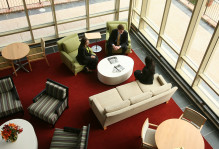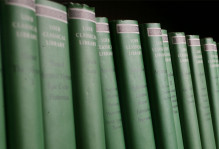Talking about Research
Over the past twenty years, I have been deeply impressed by the quality of the scholarship conducted by faculty and students at William & Mary. Here are a handful of examples.
- Our physicists publish countess articles every year in major journals and are hard at work building a world-class PhD program.
- Margaret Saha and her colleagues in the W&M biology department have developed labs and research agendas that are models for including undergraduates in the production of cutting-edge scholarship.
- Sal Saporito of our Sociology Department recently was awarded a $1 million grant by the National Science Foundation to develop an important new database of school attendance boundaries that will help policy makers improve the quality of American public education.
- We have some of the most prominent linguists in the world in the English and Anthropology Departments at W&M.
- In the Economics Department, Don Campbell is regularly included on lists of the most accomplished academic economists in the U.S.
I could go on and on, but you get the drift. Although W&M is a relatively small university, and although we place a lot of emphasis on undergraduate teaching, our faculty includes many internationally prominent scholars. And with financial assistance from the Charles Center at W&M, federal agencies such as the National Science Foundation, private organizations like the Mellon Foundation, and thousands of individual donors to the College, every year we are able to include several hundred of our undergraduate and graduate students in this research, often as coauthors.
Yesterday, our new provost, Michael Halleran, conducted a town meeting of sorts attended by a couple hundred faculty, students, and staff to discuss the role of research at W&M. Questions were raised about the proper balance between undergraduate and graduate education, the feasibility of expanding research opportunities for undergraduates, and the difficulties of conducting cutting-edge scholarly work when budgets are tight, as they are throughout higher education.
There was a broad – and I think appropriate – consensus at the session that we mesh research and teaching quite well at the College, and that W&M students probably have more opportunities to engage in meaningful research collaboration with faculty than at just about any other college or university in the nation. We can back up that claim with evidence.
Still, after the event, I couldn’t help but think that faculty, staff, and students were not really the most important audiences for that conversation. Those of us who teach and study at William and Mary are fully aware of the institution’s strengths, overall and as they relate to research. What we have not been especially good at, I’m afraid, is communicating those strengths in a compelling fashion to important outside constituencies. We need to be able to convincingly explain the importance of academic scholarship and faculty-student research collaboration, not just to ourselves, but also to alumni, parents, state legislators, private foundations, and especially the broader donor community.
I’m not arguing that there is no room for improvement in the research that we conduct at W&M, or in the integration of scholarship and teaching. Quite the opposite. But relative to our competitors, I do think that the College gets the quality and the mix pretty much right. Still, during a period of profound transition throughout American higher education, and at a time when all colleges and universities including W&M are facing daunting fiscal difficulties, it is especially important that we communicate effectively about the critical value of scholarship to the outside constituencies that can help us meet the challenges ahead.




No comments.
Comments are currently closed. Comments are closed on all posts older than one year, and for those in our archive.